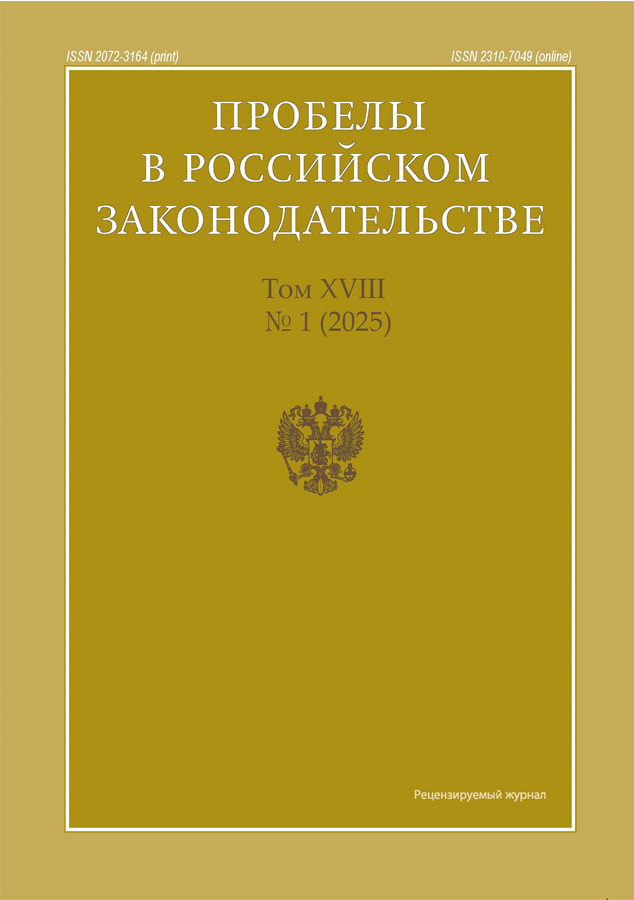Domestic violence: prerequisites, features, problems of protecting the rights of family members
- Authors: Letova N.V.1
-
Affiliations:
- Institute of State and Law of the Russian Academy of Sciences
- Issue: Vol 18, No 1 (2025)
- Pages: 80-85
- Section: Private Law (Civil) Sciences
- URL: https://journals.eco-vector.com/2072-3164/article/view/677713
- DOI: https://doi.org/10.33693/2072-3164-2025-18-1-80-85
- EDN: https://elibrary.ru/QOYAMU
- ID: 677713
Cite item
Abstract
Purpose of the study. The article examines the problems of theory and practice associated with cases of domestic violence, identifies the causes and consequences of such a social phenomenon in the sphere of family relations. The author suggests ways to solve the problem of domestic violence, proves its destructive impact not only on the family, but also on society as a whole, substantiates its negative impact on the most vulnerable family members, the post-traumatic consequences of which require the help of specialists.
Full Text
About the authors
Natalia V. Letova
Institute of State and Law of the Russian Academy of Sciences
Author for correspondence.
Email: letovanv@mail.ru
ORCID iD: 0000-0001-7033-977X
SPIN-code: 9786-0090
Dr. Sci. (Law), Chief Researcher of the Procedural Law Sector
Russian Federation, MoscowReferences
- Kutyavina E. E. Social factors of domestic violence // Bulletin of the Nizhny Novgorod University named after N. I. Lobachevsky. Series: Social Sciences. 2013. N 1(29). Pp. 35–39.
- Popova I. V. Experience of studying the problem of domestic violence // Scientific dialogue. 2012. N 4. Pp. 124–135.
- Laktionova M. A. Gender violence as an interdisciplinary problem // Bulletin of the Adyghe State University. Series 1: Regional studies: philosophy, history, sociology, jurisprudence, political science, cultural studies. 2011. N 1. Pp. 97–106.
- Baburin S. N., Baburin S. N. Moral state. Russian view on the values of constitutionalism. Moscow. 2020.
- Lukasheva E. A. Transformation processes of the 21st century: institutional context // Proceedings of the Institute of State and Law of the Russian Academy of Sciences. 2018. Vol. 13. No. 5. Pp. 13–20.
- Levitan R. D., Rector N. A., Sheldon T., & Goering P. (2003). «Childhood adversities associated with major depression and/or anxiety disorders in a community sample of Ontario: Issues of comorbidity and specificity, Depression & Anxiety»; 17. Pp. 34–42.
- Middlebrooks J. S., Audage A. C. The Effects of Childhood Stress on Health Across the Lifespan. — Centers for Disease Control, 2008; Malinosky-Rummell R., Hansen D. J.(July 1993). «Long-term consequences of childhood physical abuse». Psychological Bulletin. 114 (1), Pp. 68–79.
- Golden J. A., Prather W. (2009). A behavioral perspective of childhood trauma and attachment issues: toward alternative treatment approaches for children with a history of abuse. International Journal of Behavioral and Consultation Therapy, V.5, Pp. 56–74.
- Gauthier L., Stollak G., Messé L., Aronoff J. (July 1996). «Recall of childhood neglect and physical abuse as differential predictors of current psychological functioning». Child Abuse & Neglect. 20 (7): Pp. 49–59.
- Salamova S. Ya. Problems of preventing domestic crimes. Domestic violence in modern Russia: general characteristics. LEX RUSSIA. No. 9 (142). 2018. Pp.130–140
- Golden J. A., Prather W. (2009). A behavioral perspective of childhood trauma and attachment issues: toward alternative treatment approaches for children with a history of abuse. International Journal of Behavioral and Consultation Therapy, V.5, Pp. 56–74.
- Violence as a negative social phenomenon: legal means of counteraction / ed. N. V. Letova. Moscow, prospect, 2023. 280 p.
Supplementary files









